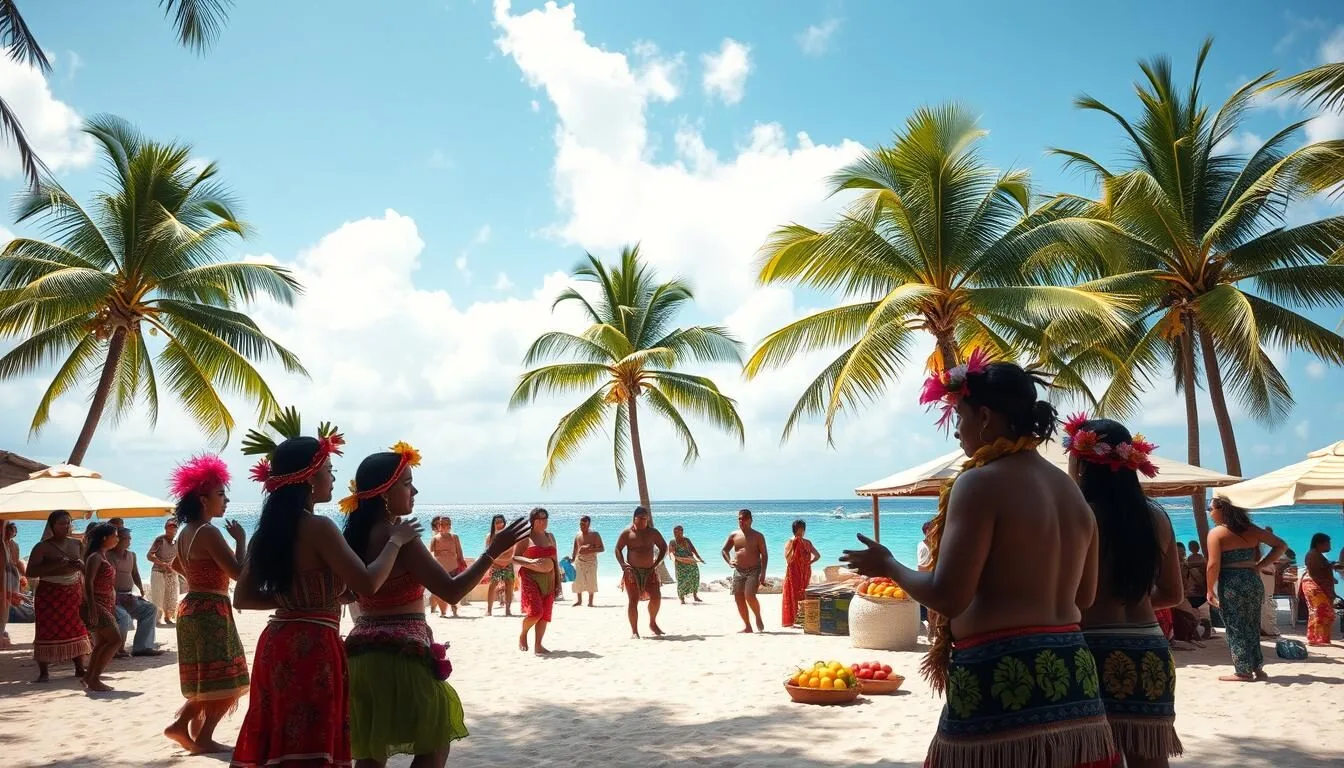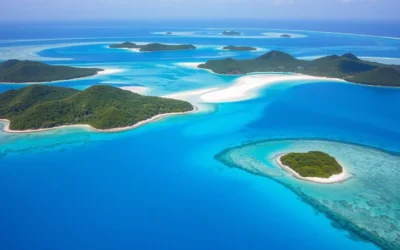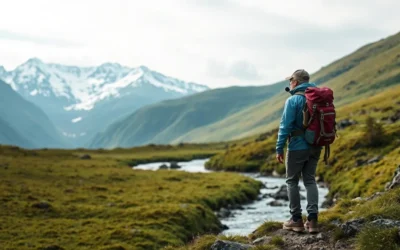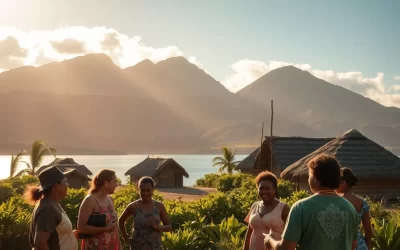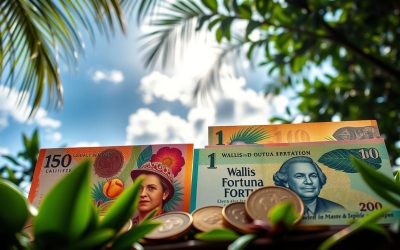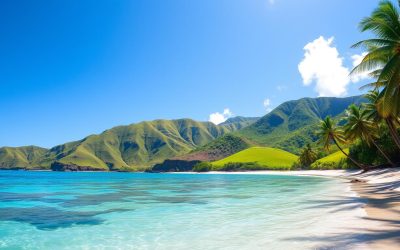✓ Accommodations ✓ Flights ✓ Rental Cars
Imagine visiting a Pacific island where traditional Polynesian culture thrives, untouched by mass tourism. With only around a hundred tourists visiting Wallis & Futuna annually, you can experience the authentic heart of these islands.
Located over 16,000 kilometers from France, Wallis & Futuna are islands of immense natural beauty, where the traditional lifestyle and lush nature are intertwined in everyday life. You’re about to uncover the vibrant festival scene that makes these islands a unique cultural destination.
From grand ceremonies to intimate rituals, you’ll get to experience the rich cultural heritage of these hidden gems in the Pacific Ocean. Get ready to immerse yourself in the local culture and create unforgettable memories.
Discovering the Hidden Gems of the Pacific
As you venture into the heart of the Pacific, you’ll discover the enchanting islands of Wallis and Futuna. This hidden gem is steeped in a rich cultural heritage, shaped by its complex history and geographical location.
Geographical Location and Cultural Significance
Wallis Island, part of the Wallis and Futuna archipelago, is a place where traditions are particularly alive. The islands’ unique location in Western Polynesia has made them a melting pot of cultures. The inhabitants of Wallis and Futuna maintain a traditional social structure, with three kingdoms that are led by customary kings alongside the French administration.
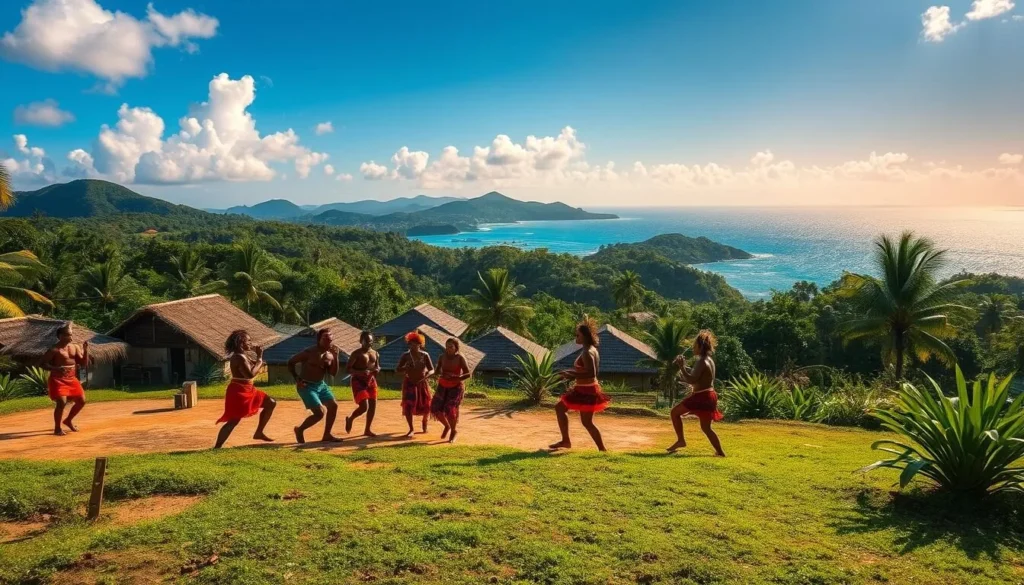
The Unique Blend of Polynesian and French Influences
In every village, you’ll experience a fascinating cultural fusion where ancient Polynesian traditions blend harmoniously with French administrative influence. The population proudly displays their dual heritage, speaking both their native languages and French, while maintaining traditional dress for ceremonies. This unique blend is an essential part of understanding the festivals and celebrations you’ll encounter, as many combine Catholic religious elements with ancient Polynesian rituals in a way that’s found nowhere else in the Pacific.
The culture of Wallis Island is a vibrant reflection of its history and the daily life of its people. As you explore the islands, you’ll find that the blend of Polynesian and French influences is not just a part of their heritage, but a living, breathing aspect of their identity.
The Cultural Heartbeat of Wallis and Futuna
Wallis and Futuna’s cultural heartbeat is most evident in its traditional festivals, which are a testament to the islands’ deep-rooted customs and practices. These festivals are not just a form of entertainment but are integral to the social fabric of the island community.
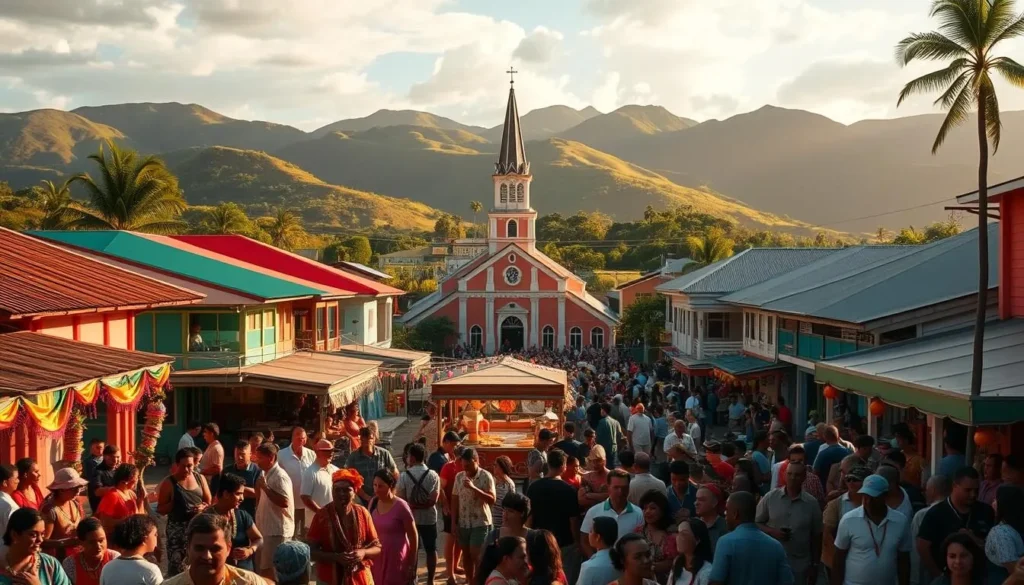
Traditional Polynesian Heritage
The islands of Wallis and Futuna are known for their customary festivals, deeply rooted in their Polynesian heritage. These ceremonies, known as Katoaga, take place during religious holidays, family events, or secular holidays like July 14 or the territory’s holiday on July 29. You’ll find that these festivals aren’t merely entertainment but serve as the backbone of the island’s social structure, reinforcing community bonds and cultural identity.
For the local population, these celebrations mark the rhythm of island life throughout the year, connecting them to both their ancestral traditions and their contemporary reality as part of France. Each village takes immense pride in hosting their patron saint celebrations, with preparations beginning months in advance and involving every family member from children to elders.
The Role of Festivals in Island Life
Festivals in Wallis and Futuna provide opportunities for families to demonstrate their status, showcase their craftsmanship, and fulfill traditional obligations through gift exchanges and contributions. When you attend these events, you’ll witness how festivals serve as living museums where cultural knowledge is passed down through generations, ensuring that traditional dances, songs, and ceremonies remain a vital part of contemporary island identity.
By participating in or observing these festivals, you’ll gain a deeper understanding of the island’s culture and the significant role that these celebrations play in the daily life of the inhabitants. The Katoaga ceremonies, in particular, are a highlight of the island’s cultural calendar, showcasing the rich heritage and traditions of Wallis and Futuna.
Katoaga: The Ultimate Traditional Ceremony
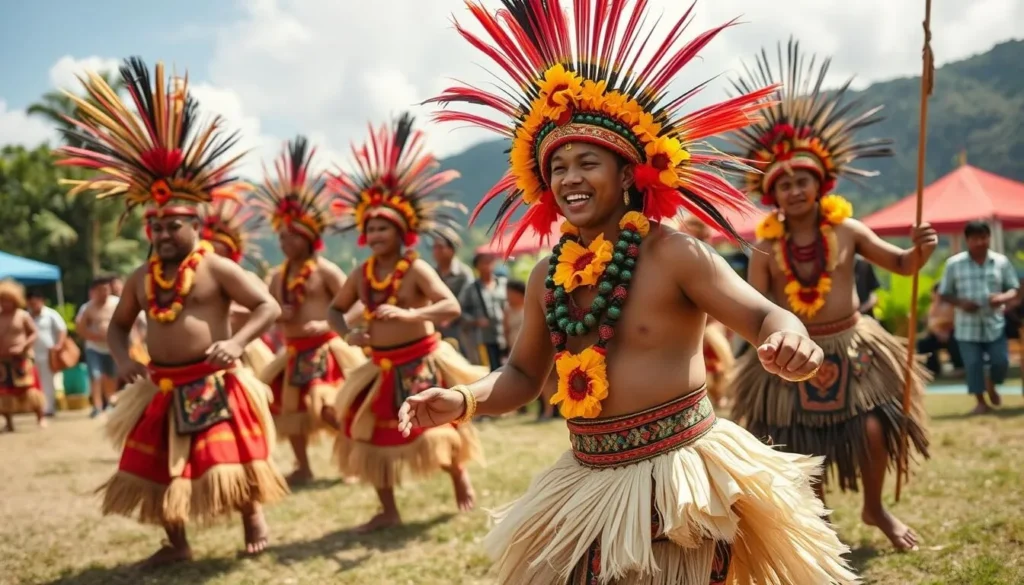
The Katoaga ceremony is a significant cultural event in Wallis and Futuna, offering a glimpse into the island’s history and traditions. As you attend this ceremony, you’ll be immersed in the local culture, witnessing firsthand the customs and practices that have been passed down through generations.
Cultural Significance
In Wallis and Futuna, Katoaga ceremonies are deeply rooted in the local culture, taking place during religious holidays, family events, or secular festivals like July 14th. These events are a time for the community to come together, celebrating their heritage and strengthening social bonds.
The Katoaga ceremony is a display of traditional wealth, including finely woven mats, tapa cloth, and elaborate food presentations prepared by families over weeks or months. This spectacle is not just a feast for the eyes but also a demonstration of the community’s respect for tradition and their ancestors.
What to Expect
As you participate in or observe a Katoaga celebration, you’ll notice the ceremony begins with a procession to the village meeting ground or church. The highlight of the event is the traditional dance performances, where dancers in vibrant costumes perform synchronized movements that tell stories of island history and mythology.
- Arrive early to witness the entire spectacle, starting with the procession.
- Expect elaborate displays of traditional wealth, including woven mats and tapa cloth.
- Enjoy traditional dance performances that narrate island stories.
- Savor the aroma of traditional foods prepared in earth ovens.
- Be respectful, as this is a time of serious cultural significance.
By attending a Katoaga ceremony, you’ll gain a deeper understanding of the cultural practices and values of Wallis and Futuna, creating memories that will last a lifetime.
Religious Festivals in Wallis and Futuna
As you explore the islands of Wallis and Futuna, you’ll discover a deep-rooted Catholic heritage that permeates every aspect of island life. The islands boast a large number of magnificent churches, with the Mata Utu Cathedral in Wallis being particularly impressive, featuring lava rock and coral walls and a richly decorated interior.
Saint Peter Chanel Feast Day Celebrations
Saint Peter Chanel Feast Day is a significant celebration in Wallis and Futuna, honoring the patron saint of the islands. The faithful make a yearly pilgrimage to Poi in Futuna, worshiping in the island’s many colorful, beautifully cared for churches, filled with fresh floral tributes.
You’ll experience the joy and devotion of the islanders as they come together to dance, sing, and make offerings, dressed in traditional costumes and wearing flower garlands.
Catholic Celebrations and Church Festivals
Catholicism is an integral part of daily life in Wallis and Futuna, with nearly the entire population practicing the faith brought by missionaries in the 19th century. Each village has its own church and patron saint, whose feast day becomes an occasion for elaborate celebrations combining religious devotion with traditional customs.
- You’ll discover that Catholic celebrations involve entire families and communities, with weeks of preparation culminating in processions, special masses, and communal feasts.
- The church buildings themselves reflect island aesthetics, with decorations of fresh flowers, handmade tapa cloth, and fine mats that demonstrate the integration of Catholicism into local cultural expressions.
When attending a church festival, you’ll be surrounded by the vibrant atmosphere, with joyful islanders dressed in their finest traditional attire.
The Kava Ceremony: A Sacred Ritual
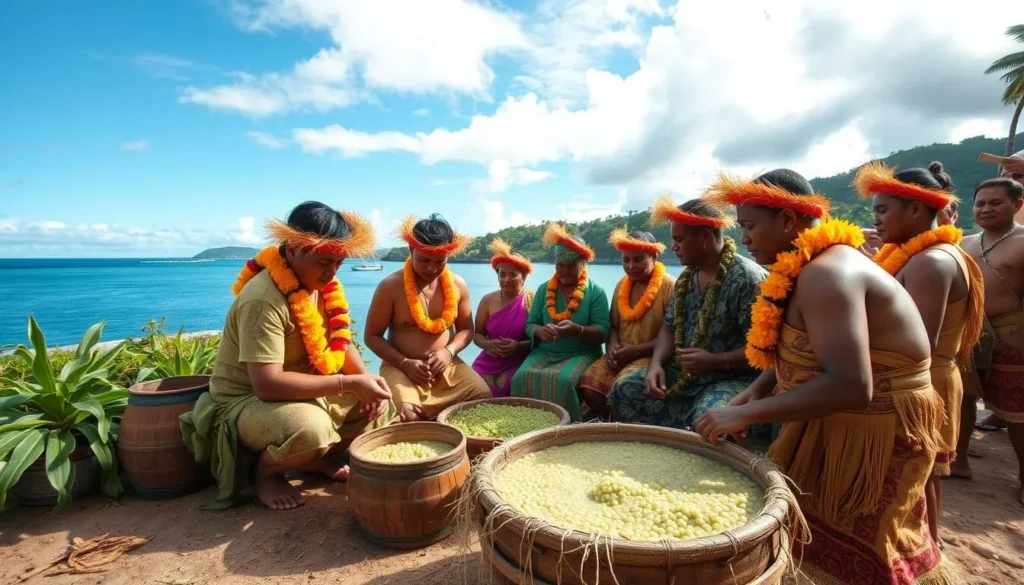
The Kava Ceremony is a sacred ritual that embodies the spirit of community and tradition in Wallis and Futuna. This ancient practice is an integral part of the island’s culture, bringing people together in a shared experience.
The History and Significance of Kava
Kava, derived from the root of a shrub, is a drink consumed during significant ceremonies, including political and religious events. In Wallis Island, kava is revered for its ability to promote relaxation and clarity of thought. Ten minutes after consumption, the heart rate and breathing slow down, and a sense of well-being is established, allowing participants to be serene and contemplative for a few hours.
Participating in a Traditional Kava Ceremony
When invited to join a kava ceremony, you’ll typically be expected to follow specific protocols. You’ll sit cross-legged, maintain a respectful demeanor, and accept the kava bowl with both hands. The preparation involves pounding dried kava root, mixing it with water in a wooden tanoa (kava bowl), creating a distinctive earthy-tasting beverage. After drinking, you’ll experience a mild numbing sensation followed by relaxation, facilitating the sharing of stories and community bonding.
You’ll find that kava ceremonies usually take place in the evening at the village fale kava (kava house). This is a unique opportunity to participate in authentic Wallis Island life. Remember to approach the ceremony with respect, taking your time to appreciate the ritual and the company of the locals, learning the way of the community.
Traditional Dance Festivals
Immerse yourself in the vibrant cultural heritage of Wallis and Futuna through its captivating traditional dance festivals. These events are a significant part of the island’s identity, reflecting the community’s history and values.
Soamako: Rhythms and Movements
During traditional Soamako dances, families gather to exchange songs and dances, including Niutao, Kailoa, and kava dance, whose synchronized gestures are of great importance. These dances mimic the tribal conflicts of yesteryear, to the sound of drums and lali, a Wallisian instrument of percussion.
Other Traditional Dances: Niutao, Kailoa, and More
You’ll discover a rich variety of traditional dances beyond the Soamako, each with its own significance, style, and place in Wallis and Futuna cultural life. The Niutao dance features seated performers making precise hand movements that tell stories through gesture, offering a different view of traditional storytelling.
When watching the Kailoa, you’ll witness a warrior dance performed primarily by men that showcases strength and agility, with movements that recall ancient battle techniques and island defense. These dances are not simply entertainment but serve as a way to preserve historical knowledge.
As part of your cultural experience, you might also see the tau’olunga (solo female dance) or the ma’ulu’ulu (sitting dance), each representing a different aspect of traditional Wallis Island expression.
Wallis and Fortuna: Top Festivals to Check Out When Visiting
When planning your trip to Wallis and Futuna, timing is everything to experience the islands’ vibrant festivals. The islands offer a unique blend of Polynesian and French cultures, making their festivals a fascinating experience.
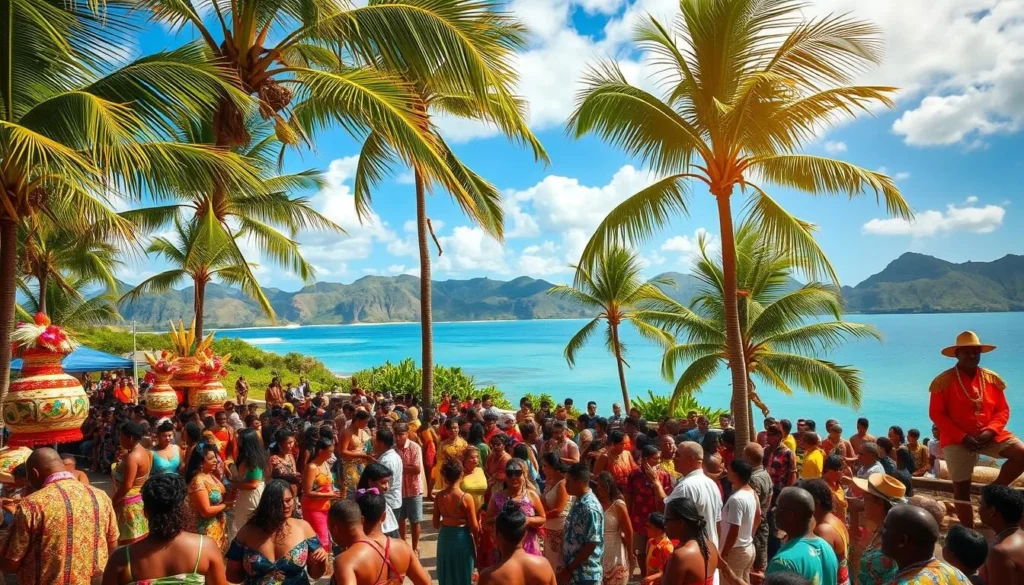
Annual Festival Calendar
Wallis and Futuna have a rich cultural calendar, with various festivals taking place throughout the year. If you schedule your stay to coincide with a traditional public holiday, such as Bastille Day on July 14 or the Territory’s national holiday on July 29, you’ll be able to join in the kava ceremony, the katoaga, enjoy traditional dances and songs, and take part in a celebratory mass.
The annual festival calendar is filled with events that showcase the islands’ unique cultural heritage. Some of the key festivals include:
- The dry season (May to October) is the best time to visit Wallis for outdoor festivals.
- July is particularly rich in cultural events, including Bastille Day and Territory Day celebrations.
- October is ideal for those interested in maritime traditions, with fishing competitions and canoe races.
| Month | Festival/Event | Description |
|---|---|---|
| July | Bastille Day | Celebrations including kava ceremony and traditional dances |
| July | Territory Day | Commemoration of the territory’s national holiday |
| October | Fishing Competitions | Celebration of maritime traditions |
Seasonal Celebrations Worth Planning Your Trip Around
Certain seasons offer unique festival experiences in Wallis and Futuna that are worth planning your entire trip around. For instance, Easter week provides a profound cultural experience as the islands combine Catholic traditions with local customs, featuring processions, special masses, and community gatherings.
If you have flexible travel days, consider visiting during the monthly market (typically held the first Saturday of each month), which offers a smaller but still authentic cultural gathering where you can experience local crafts, foods, and performances.
Plan your trip to Wallis and Futuna during the festival season to experience the islands’ vibrant culture. With a range of events and celebrations throughout the year, you’re sure to find a festival that suits your interests.
The Monthly Market: A Feast for the Senses
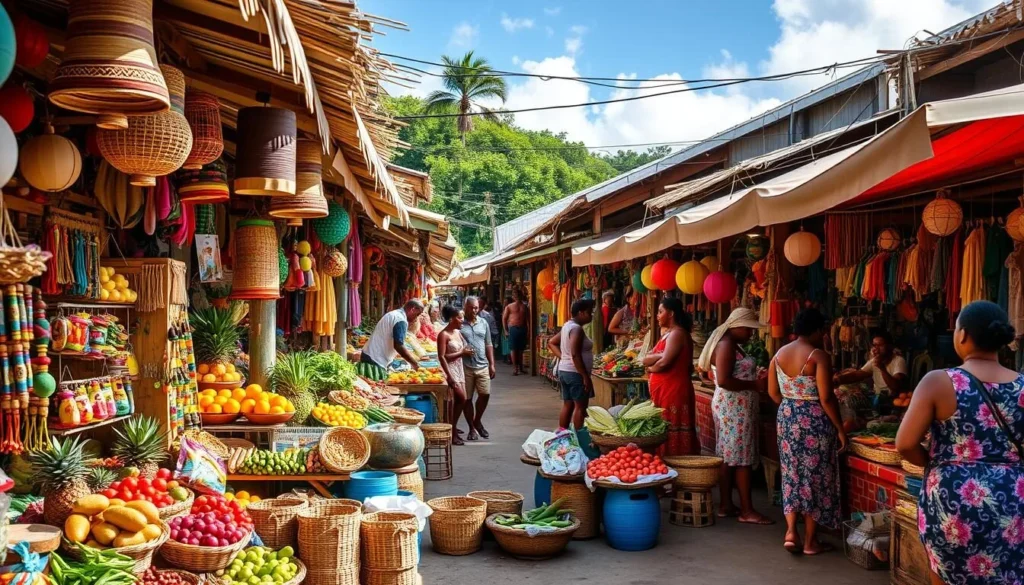
Every month, the Fuga’Uvea market in Tepa village transforms into a vibrant showcase of local crafts and cuisine. You can indulge in a variety of local products, from handmade basketry and jewelry to traditional clothing and sculptures. The market is an ideal place to meet local artisans and exchange stories with beekeepers and farmers.
Local Crafts and Artisanal Products
The market offers a wide range of artisanal products that reflect the rich cultural heritage of Wallis and Futuna. You can find unique handmade ornaments, traditional Polynesian clothing, and intricate sculptures that make for perfect souvenirs. The local crafts on display are a testament to the island’s skilled artisans.
Culinary Delights and Fresh Produce
The market is a paradise for food lovers, with stalls offering fresh tropical fruits, vegetables, and prepared dishes that showcase the island’s unique culinary heritage. You can sample local specialties like ota ika (raw fish marinated in coconut milk and lime) and palusami (taro leaves with coconut cream), and enjoy freshly caught seafood from the surrounding sea. The influence of French eating habits is evident in the marinated chicken and pork dishes, while coconut remains the base of the local cuisine.
As you explore the market, you’ll discover homemade preserves, including tropical fruit jams, honey from island bees, and achard (spicy pickled vegetables). You can also watch demonstrations of traditional cooking methods, such as the preparation of an umu (earth oven), where food is cooked on hot stones covered with banana leaves, infusing everything with a distinctive smoky flavor.
Maritime and Fishing Festivals
Get ready to experience the thrill of maritime and fishing festivals in Wallis and Futuna, where the islanders’ passion for the sea comes alive. The archipelago offers many ways to actively explore its surroundings, both marine and land.
Va’a Canoe Racing Events
Va’a canoe racing is a popular event in Wallis and Futuna, showcasing the islanders’ skill and strength. The Va’a canoe, a traditional outrigger canoe, is an integral part of the island’s maritime culture. You’ll witness thrilling competitions as teams paddle through the lagoon surrounding Wallis island, demonstrating their mastery of the sea.
Traditional Fishing Competitions
Fishing competitions are fascinating cultural events that showcase traditional skills still vital to island life in Wallis and Futuna. These contests typically take place in the lagoon surrounding Wallis island, with different categories including spearfishing, net fishing, and traditional line fishing using methods passed down through generations.
During major festivals, fishing competitions become community events where teams representing different villages compete not just for the biggest catch but for demonstrating the most skillful traditional techniques. You’ll be amazed by the variety of fishing methods on display, from night fishing with torches to the cooperative technique of fish driving, where groups work together to herd fish into shallow waters.
Practical Tips for Festival Visitors
Attending a festival in Wallis and Futuna is a great way to immerse yourself in the island’s culture, but it’s crucial to do so respectfully. As you participate in the vibrant celebrations, being mindful of the local customs and traditions will enhance your experience and that of those around you.

Best Times to Visit for Cultural Experiences
Planning your visit to coincide with significant cultural events can be rewarding. The island hosts various festivals throughout the year, each offering a unique insight into the local way of life. By timing your trip around these events, you can be a part of the island’s rich cultural heritage.
What to Wear and Bring
When attending a festival on Wallis Island, dressing modestly is advised. You should also be prepared for the tropical climate by bringing appropriate clothing and sun protection. Removing your shoes before entering a village or private home is a sign of respect, especially during indoor festivities.
Cultural Etiquette to Observe
During ceremonies, always ask permission before taking photographs, as some rituals may be considered private. If offered kava, accept it with both hands and drink it in one go as a sign of respect. Observing the local way of showing respect to chiefs and elders is also important; this includes not standing when they are seated and keeping your head lower than theirs when passing by. By being respectful, you become a considerate guest in their village.
Capturing Memories: Photography at Festivals
As the festivities unfold in Wallis and Futuna, your camera lens becomes a window to the soul of the Pacific Islands. The vibrant colors, dynamic performances, and rich cultural heritage offer a wealth of photographic opportunities.
Respectful Photography Practices
When capturing the essence of Wallis and Futuna’s festivals, it’s crucial to be respectful. Arriving early to secure a good vantage point not only provides an unobstructed view but also shows respect for the participants. Be mindful of your surroundings and the people you’re photographing.
Best Vantage Points and Moments
For the best festival photographs, consider the timing and your place in the crowd. The golden hours of early morning and late afternoon offer soft, flattering light that enhances the vibrant colors of traditional costumes and decorations. Positioning yourself to capture both the full formations of dance performances and close-up expressions can convey the depth of the cultural experience. Some of the most compelling moments occur during transitions between formal parts of ceremonies, when participants are more relaxed.
| Photography Tip | Benefit |
|---|---|
| Arrive Early | Secure a good vantage point with an unobstructed view |
| Golden Hours | Soft, flattering light for vibrant colors |
| Capture Transitions | Natural interactions and relaxed moments |
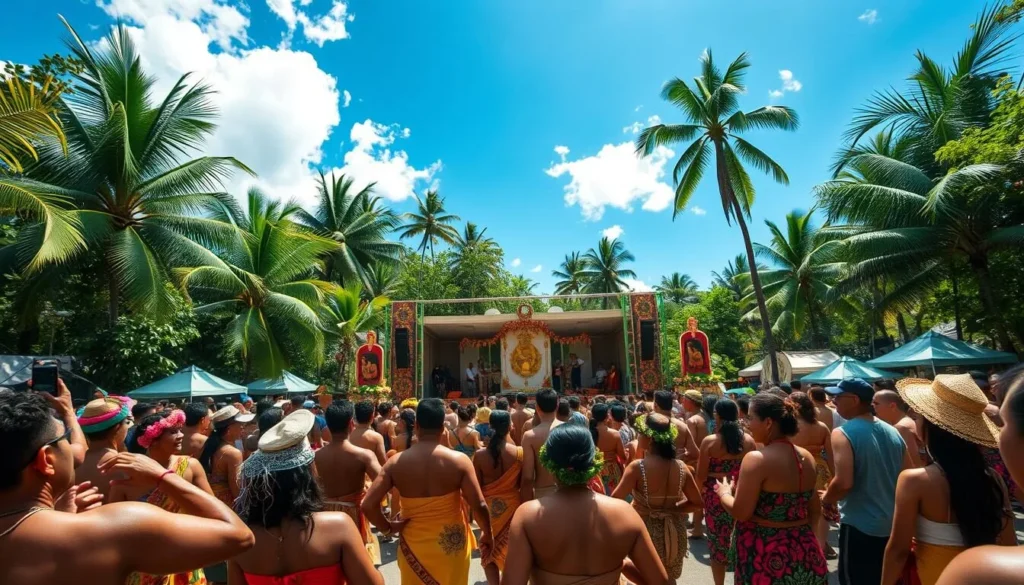
By being prepared to stay for hours and immersing yourself in the festivities, you can capture the true essence of Wallis and Futuna’s cultural celebrations, creating lasting memories of your visit to Wallis Island and the broader Wallis Futuna region.
Where to Stay During Festival Season
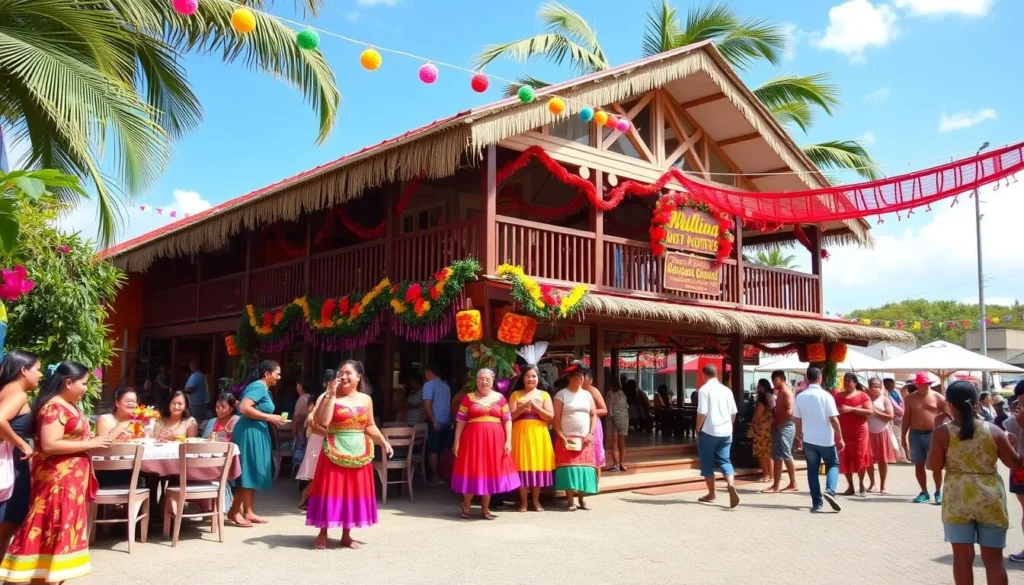
If you’re planning to visit Wallis and Futuna for their festivals, you’ll need to book your accommodation wisely. The islands have limited options, especially during peak festival seasons.
Accommodation Options in Wallis
Wallis Island offers a few more accommodation options compared to Futuna. You can find hotels and guesthouses that provide basic amenities. It’s essential to check with the Wallis and Futuna Tourism website for updated contact information, as online booking is generally not available.
Places to Stay in Futuna
Futuna has two hotels: Hotel Fitu Anu near Leava and Moana Hotel, both offering basic but clean rooms. For a more authentic experience, consider the limited homestay options where local families open their homes to visitors. Book well in advance, especially for the Saint Peter Chanel celebrations in April, as rooms fill quickly.
Most accommodations can arrange airport pickup and help coordinate your attendance at local festivals. There are three inter-island flights between Wallis and Futuna a week, with a flight time of one hour. It’s advisable to contact a local travel agency to book your flight and accommodation.
Conclusion: Embracing the Festive Spirit of Wallis and Futuna
As you consider visiting Wallis and Futuna, you’re on the cusp of an unforgettable journey into the heart of Pacific cultural heritage. The islands offer a rare opportunity to experience authentic cultural practices that remain vibrant and untouched by mass tourism.
When you travel to Wallis and Futuna for a festival, you’re not just a spectator; you become part of a living tradition that connects the present with centuries of island history. The unique blend of Polynesian and French influences has created a cultural paradise that is worth exploring.
As you plan your trip to these remarkable islands, remember to approach with respect, openness, and gratitude for being welcomed into the extraordinary world of the Wallisian and Futunan people. By doing so, you’ll not only enrich your travel experience but also contribute to the preservation of their cultural identity.
The above is subject to change.
Check back often to TRAVEL.COM for the latest travel tips and deals.
